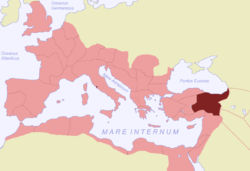Cappadocia (Roman Province)
|
Roman Province of Cappadocia (Roman Province) |
|
|---|---|

|
|
| Cappadocia Province in the Roman Empire | |
| Predecessor: | Kingdom of Cappadocia |
| Roman since: | 18 AD |
| Successor: | Armeniacon |
| Administrative center: | Caesarea |
Cappadocia , now known as Cappadocia , is the Latin name of an ancient landscape and Roman province in eastern modern-day Turkey , as well as much of the eastern Asia Minor .
Although Cappadocia never achieved any significant status in the Roman Empire , it was an important border area against the Parthian Empire . It later became one of the most important sites for the early Christians and part of Byzantium after the division of the empire .
history
Cappadocia had always been part of numerous empires before it was annexed by the Romans. It was a satrapy under the Achaemenids and later, after the fall of the Persian Empire, was divided into two independent kingdoms under the rule of Mithridates and Ariarathes , between which the dynasty of Mithridates proved to be the dominant one. Under him, Cappadocia became part of the empire of Pontus and there were attempts at a Hellenization, which were, however, characterized by rather moderate success, so that Cappadocia was always seen as a little backward compared to other parts of the area occupied by the Diadochi .
Since the increase in Cappadocian power was not in Rome's interest, the Roman Senate supported the election of Ariobarzanes I and declared Rome a protective power, which should protect him against the constant threat from Tigranes II of Armenia . Cappadocia thus became dependent on Rome and caught up in Roman intrigues and the influence of Roman military commanders who fought each other in the civil wars of the Roman Republic and who sought influence in the east. This became clear when the line of Ariobarzanes was deposed by Mark Antony and Archelaos Sisines was raised to the new king.
As a province
In 18/19 AD, Cappadocia completely became a Roman province under Emperor Tiberius , who had the ruler still appointed by Marcus Antonius deposed after a Roman procurator had previously been assigned to him. Tiberius followed up on the existing systems of rule, which were already extremely efficient and enabled the barren province to be used economically. The province was initially administered by a knightly procurator who resided in the city of Mazaka (later renamed Caesarea) and was subordinate to Tiberius himself. However, since Cappadocia was part of the border area with the Parthian Empire, the province was reorganized several times for security reasons; so the old Cappadocia was united under Vespasian with Armenia Minor and the provinces Galatia and Pontus . The new Greater Province was placed under a consular governor, who retained his post even after Trajan made Galatia an independent province again.
Although Cappadocia was on the borders of the Roman Empire, it experienced a fairly peaceful period well into the 3rd century. However, offensives by the Sassanids and Goths from the 3rd century onwards led to the destruction of numerous cities, including Tyana , Kybista and even Caesarea. Subsequently, the confidence of the Cappadocian people in the Roman military power was broken, which should make the province vulnerable to the conversions of the early Christians.
In late antiquity , Cappadocia became an important place of early Christianity . There, among others, Basilius the Great , Gregory of Nazianzen and Gregory of Nyssa , who are also referred to as the three Cappadocian church fathers , worked. Christianity spread rapidly among the population, so that the province could be considered a largely Christian country from the middle of the 3rd century. The province was divided into Cappadocia prima and Cappadocia secunda by Valens in 372 and after the division of 395 it fell to the Eastern Roman Empire as part of the province of Armenaikon.
Quirks
The inhabitants of the province of Cappadocia had been able to retain a large part of their old way of life, as the province was not as Hellenized as other provinces in Asia Minor. Large parts of the country remained in the hands of the nobility and temple princes, and a large part of the population was dispossessed and unfree. Cappadokers had a reputation for being clumsy and difficult to understand, which earned them the derision of their contemporaries.
The province of Cappadocia possessed numerous natural raw materials, such as marble , alabaster , lead , silver and iron . The majority of the population was dominated by agriculture and lived from cattle breeding and grain cultivation . Despite these numerous natural raw materials, the province was rather poor in comparison to the Roman Empire, as the winters were often harsh and forced the population to seek shelter in the country's natural caves.
Cappadocia was also known for its horse breeding , which had its center north of the Argaeus mons . The Cappadocian horses were famous for their military fitness, which was already recognized and promoted by the Persians. They were also very popular for chariot races and were able to compete with other competitive animals from Hispania , Sicily and Lusitania .
Remarks
- ↑ Cassius Dio 57, 17, 3.
- ↑ Strabo 7, 2, 10.
- ↑ Strabo 7, 2, 7 and 9.
literature
- Tilmann Bechert : The provinces of the Roman Empire. Introduction and overview. von Zabern, Mainz 1999, ISBN 3-8053-2399-9 , pp. 147-150
- Raymond Van Dam: Kingdom of Snow. Roman Rule and Greek Culture in Cappadocia , University of Pennsylvania Press, Philadelphia 2002, ISBN 0-8122-3681-5
- Raymond Van Dam: Families and friends in late Roman Cappadocia . University of Pennsylvania Press. Philadelphia 2003, ISBN 0-8122-3712-9